I have the following Swift script:
#!/usr/bin/env swift
import AppKit
import Foundation
let app = NSApplication.shared
app.setActivationPolicy(.regular) // Magic to accept keyboard input and be docked!
struct DialogError: Error, LocalizedError {
let errorDescription: String?
init(_ description: String) {
errorDescription = description
}
}
struct Settings {
var title: String
var text: String
var okButton: String
var cancelButton: String
var width: Int?
var height: Int?
}
struct ListOptions {
var options = [String]()
var defaultOption = 0
var multiple = false
}
class TableViewController: NSViewController, NSTableViewDelegate, NSTableViewDataSource {
var initialized = false
var frame = NSRect()
var opts = ListOptions()
var defaultOption = 0
var tableView = NSTableView()
convenience init(frame: NSRect, options: ListOptions) {
self.init()
self.frame = frame
self.opts = options
self.tableView = NSTableView(frame: frame)
self.view = self.tableView
}
override func viewDidLayout() {
if !initialized {
initialized = true
setupTableView()
}
}
func setupTableView() {
self.tableView.delegate = self
self.tableView.dataSource = self
self.tableView.headerView = nil
self.tableView.allowsMultipleSelection = self.opts.multiple
self.tableView.usesAutomaticRowHeights = true
self.tableView.backgroundColor = NSColor.clear
self.tableView.selectionHighlightStyle = NSTableView.SelectionHighlightStyle.regular
self.tableView.selectRowIndexes(
IndexSet(integer: self.opts.defaultOption), byExtendingSelection: false)
//tableView!.appearance = NSAppearance(named: NSAppearance.Name.vibrantDark)
let col = NSTableColumn(identifier: NSUserInterfaceItemIdentifier(rawValue: "col"))
col.minWidth = 200
tableView.addTableColumn(col)
}
func numberOfRows(in tableView: NSTableView) -> Int {
return self.opts.options.count
}
func tableView(_ tableView: NSTableView, viewFor tableColumn: NSTableColumn?, row: Int)
-> NSView?
{
let text = NSTextField()
text.stringValue = self.opts.options[row]
text.isEditable = false
text.drawsBackground = false
text.isBordered = false
let cell = NSTableCellView()
cell.addSubview(text)
text.translatesAutoresizingMaskIntoConstraints = false
cell.addConstraint(
NSLayoutConstraint(
item: text, attribute: .centerY, relatedBy: .equal, toItem: cell,
attribute: .centerY,
multiplier: 1, constant: 0))
cell.addConstraint(
NSLayoutConstraint(
item: text, attribute: .left, relatedBy: .equal, toItem: cell, attribute: .left,
multiplier: 1, constant: 0))
cell.addConstraint(
NSLayoutConstraint(
item: text, attribute: .right, relatedBy: .equal, toItem: cell, attribute: .right,
multiplier: 1, constant: 0))
return cell
}
func tableView(_ tableView: NSTableView, rowViewForRow row: Int) -> NSTableRowView? {
let rowView = NSTableRowView()
rowView.isEmphasized = true
return rowView
}
}
func makeDefaultAlert(_ settings: Settings, listOpts: ListOptions) -> (NSAlert, TableViewController) {
let a = NSAlert()
a.messageText = settings.title
a.alertStyle = NSAlert.Style.informational
a.addButton(withTitle: settings.okButton)
a.addButton(withTitle: settings.cancelButton)
a.buttons[0].keyEquivalent = "\r"
a.buttons[1].keyEquivalent = "\u{1b}"
// Text as accessory view since
// Height can not be changed
let v = NSStackView(frame: NSRect(x: 0, y: 0, width: settings.width ?? 250, height: 350))
// ---------------------------------------------------------------------------** This is a problem HERE. I dont know the height...
v.orientation = NSUserInterfaceLayoutOrientation.vertical
v.distribution = NSStackView.Distribution.equalSpacing
v.spacing = 10
// Text 1
let text = NSTextField(wrappingLabelWithString: settings.text)
text.isEditable = false
text.drawsBackground = true
v.addView(text, in: NSStackView.Gravity.center)
// Text 2
let text2 = NSTextField(wrappingLabelWithString: settings.text)
text2.isEditable = false
text2.drawsBackground = true
v.addView(text2, in: NSStackView.Gravity.center)
//Table
let scrollView = NSScrollView(
frame: NSRect(x: 0, y: 0, width: settings.width ?? 250, height: 100))
scrollView.hasVerticalScroller = true
scrollView.hasHorizontalScroller = true
let clipView = NSClipView(frame: scrollView.bounds)
clipView.autoresizingMask = [.width, .height]
let con = TableViewController(frame: clipView.bounds, options: listOpts)
con.tableView.autoresizingMask = [.width, .height]
clipView.documentView = con.tableView
scrollView.contentView = clipView
v.addView(scrollView, in: NSStackView.Gravity.center)
a.accessoryView = v
return (a, con)
}
func runOptionsDialog() throws {
let text = """
Lorem ipsum dolor sit amet, consetetur sadipscing elitr, sed diam nonumy eirmod tempor invidunt ut labore
et dolore magna aliquyam erat, sed diam voluptua. At vero eos et accusam et justo duo dolores et ea rebum.
Stet clita kasd gubergren, no sea takimata sanctus est Lorem ipsum dolor sit amet.
"""
let listOpts = ListOptions(options: ["option1", "option2"], multiple: true)
let settings = Settings(title: "Title", text: text, okButton: "Ok", cancelButton: "Cancel")
let a = makeDefaultAlert(settings, listOpts: listOpts)
let alert = a.0
app.activate(ignoringOtherApps: true)
alert.runModal()
}
try runOptionsDialog()
When running swift script.swift this creates succesfully the following alert:
The scrolling is perfect, but I want that the whole NSStackView in makeDefaultAlert(...) scales to the complete height of the subviews, without having to give it a height: 500 such that everything fits perfectly. How can we automatically adjust a parent view depending on its subviews, here 2 NSTextFields and 1 NSScrollView (table). I am having a hard time to understand if I need some constraints or something like that, which I have no clue how to setup programatically?
